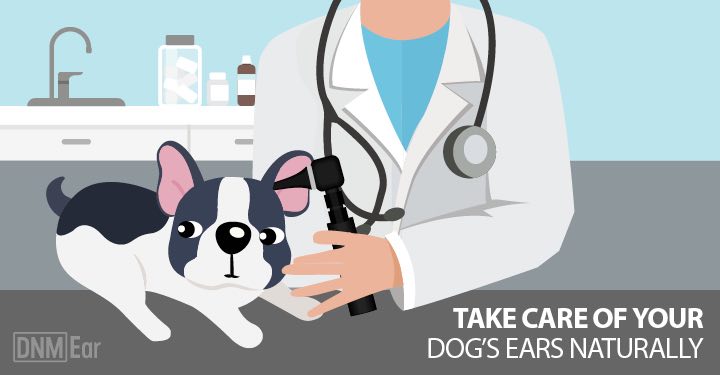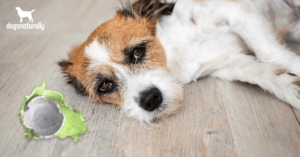Itchy dog ears often go hand in hand with allergies and sensitivities, and dogs who are prone to itchy skin and hot spots frequently suffer with ear issues as well. As with most skin conditions, a problem with the ears is often indicative of some other internal issues going on deep within the body.
Certain types of bacteria and yeast are naturally present throughout the body, including the ears. They are part of the balance of life, but when the balance is disrupted, the result can be a yeast infection in dogs, which can result in an ear infection. A conventional veterinary approach to ear problems often involves the prescribing of antibiotics as well as steroids and other medications, which can provide some immediate relief.
The problem is that these products work by suppressing the symptoms and the immune system, so this tends to be only a temporary fix and doesn’t actually offer a true, long-term cure. Because ear and skin issues are often caused by autoimmune disorders, drugs that suppress the immune system will appear to work as the inflammation and redness will disappear.
But the logic of suppressing the immune system may not be the best approach because this leaves the dog susceptible to bacteria, viruses and more sinister illnesses.
Why Your Dog Is Scratching His Ears
One of the first signs of an ear infection is the dog shaking his head and scratching at his ears. Otitis (inflammation of the ear canal) is usually accompanied by redness of the ear flaps.
Often, the sign of an underlying ear problem can be extremely subtle, such as a very slight tilt of the head, or one ear being held at a slightly different angle than the other.
An odor that emanates from the ears is another tell-tale sign. The odor is usually a pungent, yeasty smell and is accompanied by a dark reddish brown buildup of waxy substance around the folds of the ears and deeper within the ear canal itself. Some dogs can be in such discomfort that they can cause damage to their ear flap (pinna) from the scratching and repeated shaking over time.
Such damage can be a nightmare to overcome, because the ear scratching and head shaking can knock off the tiny scabs that form along the bottom of the pinna, causing yet more bleeding. Any attempted cleaning or treatment of the ear itself almost always results in even more shaking right afterwards as well.
Sometimes, a ‘civil war bandage’ which fastens the dog’s ears to the side of his head, is recommended for ear flap scabs and bleeding, with the intention being to have a scab stay on long enough for healing to take place underneath – but of course keeping the ears down in this manner is even more detrimental for the inner ears where the underlying problem exists, because it prevents any air from circulating.
A better approach than bandaging is to apply generous amounts of thick calendula cream or other chemical- free moistening, lubricating creams, to keep the tips of the ear flaps softened and reduce the buildup of scabs.
In severe cases of prolonged ear scratching and head shaking, a dog ear hematoma (swelling, caused by a buildup of blood and fluid under the skin) can develop in the pinna, however this is thought to be due primarily to a type of autoimmune disease which weakens the blood vessels of the pinna, making them more prone to rupture.
4 Causes Of Itchy Ears And Head Shaking In Dogs
1. Anatomy or Breed
Certain breeds with ears that hang down, like setters, spaniels and retrievers, can be predisposed to infections and yeast buildup because these longer ear flaps provide an internal ear environment that’s dark, potentially more moist, and perfect for the growth of yeast and bacteria.
While some breeds are routinely subjected to ear-cropping in the United States, this is almost entirely a cosmetic (and in the opinion of most, cruel) surgical mutilation with its roots in the ancestral jobs of certain working breeds, but which has no relevance in the life of a modern dog – and only very mildly helps to combat ear problems, if at all.
2. Diet
Food (or environmental) allergies are especially likely to be implicated in ear problems when both ears are involved. An excess of grain and/or sugar in the diet is one of the most common causes of ear infections in dogs. The sugar actually feeds the yeast which lives naturally in the body and causes a yeast overgrowth, which results in the dark, yeasty-smelling buildup that can occur inside the ears.
3. Lifestyle
Those dogs who regularly swim in lakes, the ocean or swimming pools can be more prone to ear problems than those who don’t go near the water. Any dog who swims should have his ears gently dried afterwards, using a soft towel or cotton ball to remove the excess moisture. This alone can prevent many ear infections from building up, because yeast and bacteria love to reproduce in dark, moist places.
Dogs who spend a lot of time outdoors and are lucky enough to run in the woods or other grassy open spaces, are at slightly more risk of a foxtail or other type of grass seed working its way into the ears.
This can cause severe pain and discomfort and often requires surgical removal although in some cases, a vet may suggest pouring mineral oil or another substance into the ear to soften the seed and allow it to be shaken out by the dog – however it’s essential that a correct diagnosis is made before this approach is taken and it should only be attempted under veterinary supervision.
The homeopathic remedy Silicea is also good for expelling foreign bodies out of the skin. Give 6x every hour until the foxtail is gone.
4. Parasites
Parasites such as ear mites in dogs can invade the ear canal but these are relatively uncommon in dogs. Sometimes, allergic ear problems can be mistaken for ear mites. If they do invade, a confirmed case of ear mites can be treated with Neem or plain mineral oil.
How To Treat Itchy Ears In Dogs
Cleaning
Most dogs’ ears do not require regular cleaning and can mostly be left alone. In fact, it’s better to leave normal, healthy ears alone and not attempt to clean them for the sake of it, because this in itself can disrupt the delicate pH balance and natural environment there.
Some dogs with chronic issues require occasional cleaning to remove debris, or a specially designed drying product to help eliminate excess moisture from the ears after swimming. Minor amounts of debris can be removed with a clean, dry cotton pad alone, which is the best solution for maintaining ears that don’t have a deep-seated problem of any kind. Never try to clean beyond the areas of the ears that you can actually see.
Diet
A grain-free diet is almost always helpful in combating chronic yeast infections. Grains contain natural sugars upon which yeasts can feed and multiply. In most mild cases, eliminating grains and cleaning the ears of any built up debris will set your dog on a path to long-term ear health.
A raw or natural, minimally processed diet can be very helpful in combating ear problems, because it provides the natural, whole-food nutrition that the dog’s immune system needs in order to function optimally. Removing toxic chemical preservatives and excessive gluten, by-products and fillers can have a marvelous effect on most of the body, including the condition of the ears.
Topical Treatments
A number of good, natural commercial products are also available from pet supply and health food stores. Altering the pH of the ear is a primary step in combating yeast and bacterial infections. A basic ear cleaner can be prepared at home, and works double duty to correct the pH and kill any contaminants residing there.
Make up a solution with 1 cup of lukewarm water and 2 tablespoons of one or more of the following: hydrogen peroxide, apple cider (or white) vinegar or plantain tincture. This mixture can be used to wipe out excess debris from visible areas of the ear. Topical treatments can be used routinely, or on an as-needed basis, to clean the ears – usually by applying the product onto a cotton ball and very gently wiping out excess wax and buildup.
It’s essential not to push anything into the ear canal beyond the visible outer folds of the ear, because doing so can cause extreme and very painful damage to the delicate internal workings of the ear. Never poke Q Tips or anything else right inside the ear canal and don’t squirt or pour large volumes of these topical applications into the ears; a small amount on a cotton ball is usually sufficient.
Calendula
Calendula lotion is a nice product for topical use because it has wonderful healing properties, as does comfrey, which can also be applied to the ears.
Mullein
Mullein Oil is also an excellent ear product that’s recommended by some holistic veterinarians for basic ear infections.
6 Remedies For Dog Ear Infections
1. Pulsatilla
Pulsatilla is helpful for acute flare-ups with sensitivity and redness, along with a yellowish discharge. Pulsatilla animals like to sit near open windows, hate getting their paws wet and won’t go out in the rain. They also tend to have a very sweet (and slightly needy) disposition.
2. Hepar Sulph
Hepar sulph is useful for irritable animals who don’t like to have their inflamed ears touched.
3. Sulphur
Sulphur is often recommended for long term, stubborn skin conditions and also has some success in ear infection treatment. Excessive scratching or pawing at the ears may be an indicator for Sulphur.
4. Silicea
Silicea is worth considering to help ‘push out’ a foxtail or other foreign object from the ears.
5. Phosphorus
Phosphorus is a good option for those dogs who suffer from cuts or hematomas to the pinna; it’s an excellent remedy for many types of bleeding.
6. Tellurium
For animals that have a severe, malodorous discharge that causes hair loss around and under the ears, Tellurium is helpful. The ears are extremely sensitive in the Tellurium patient, and the discharge may have a fish-like smell.
Treating itchy dog ears (especially those that are stubborn and persistent) can be a very frustrating exercise. Deep-seated infections can take a very long time to truly and permanently resolve. Natural remedies and a truly holistic approach that also considers diet and lifestyle can be pivotal in achieving a lasting cure.
Related: Natural remedies for dog ear infections THAT WORK …]













